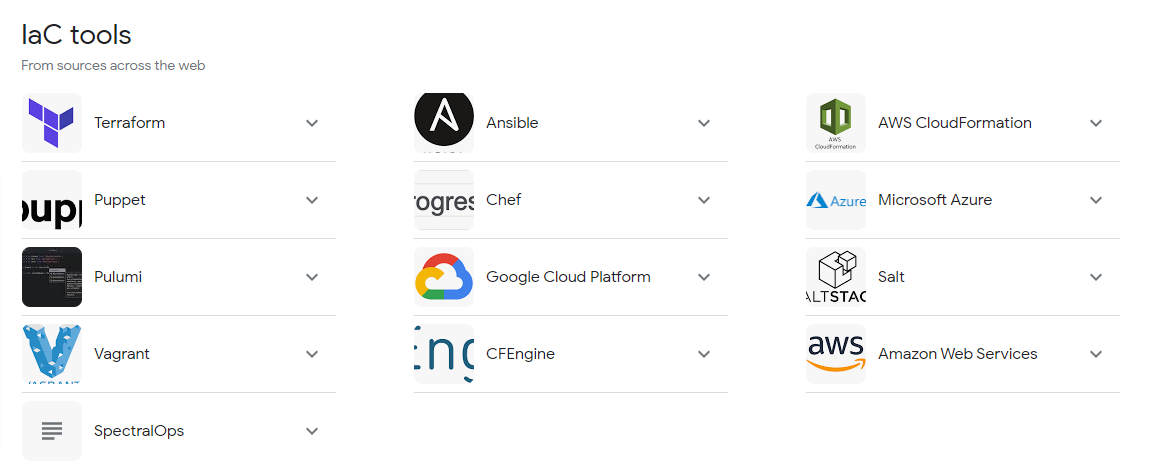The Infrastructure as Code Market is set to hit USD 2.3 billion by 2027, with a remarkable 24.0% CAGR during 2022-2027, as per MarketsandMarkets.
What does this mean for you?
What is Infrastructure as Code?
Which top Infrastructure as Code tools should you employ to secure a portion of this expanding market?
Find answers to all these questions and a detailed drill-down of two top IaC tools – Terraform and Pulumi – in the blog below.
Read on.
Before we get to Terraform vs. Pulumi, let’s understand…
What is IaC?
Infrastructure as Code (IaC) is a practice in which software code is used to define, configure, and manage IT infrastructure. This approach treats infrastructure as if it were software, enabling consistent and automated deployment and management.
For instance, imagine creating a website.
Instead of manually setting up servers and databases, you code the infrastructure requirements. Just like a recipe for a dish, where the ingredients and steps are defined, IaaC specifies the components and steps to create and manage infrastructure.
This streamlines processes, reduces errors, and allows teams to efficiently scale and replicate infrastructure, just like duplicating a successful recipe.
Benefits of Infrastructure as Code (IaC)
- Automation and Consistency: IaC automates the provisioning and configuration of infrastructure, ensuring uniform setups across environments.
- Scalability and Flexibility: IaC allows swift and seamless scaling by replicating infrastructure code, adapting to varying workloads.
- Faster Deployment: With predefined code, IaC speeds up deployment cycles, enabling quicker delivery of applications and services.
- Reduced Errors and Manual Tasks: By eliminating manual setup, IaC minimizes human errors and the need for repetitive configuration tasks.
- Version Control and Collaboration: IaC’s code-based approach enables version tracking, simplifying collaboration among teams and facilitating rollbacks.
IaC Tools: What, Why, and Which?
Infrastructure as Code (IaC) tools are software solutions that enable you to define, manage, and provision IT infrastructure using code. They replace manual configurations with code-based templates, making infrastructure setup repeatable, automated, and consistent.
Why Should IaC Tools Be Used?
Using IaC tools brings numerous benefits, including:
- Faster and error-free deployments,
- Streamlined collaboration,
- Version control,
- Scalability, and
- Reduced operational costs.
In short, IaC tools enable DevOps practices, improve agility, and reduce human error in managing complex infrastructure setups.
Now there are several IaC tools available in the market today.

Now out of these tools, Terraform is the most popular in the market. An open-source solution with almost 30% of the market share, Terraform remains a top choice.
But new options like Pulumi are also quickly gaining ground.
In fact,

Read the complete report here.
So which Infrastructure as Code tool – Terraform or Pulumi should you choose?
Should you go with the long-standing market leader?
Or should you place your bets on the rising star in the market?
Read on for a detailed Terraform vs. Pulumi comparison and make the right IaC tool choice today.
Terraform Vs. Pulumi – Which IaC Tool Should You Use?
What is Terraform?
Terraform is an open-source tool by HashiCorp that uses code to create and manage cloud infrastructure.
Why: It eliminates manual setup, reduces errors, and enables consistent infrastructure management.
History: Released in 2014, Terraform has gained widespread adoption and a strong community.
Market Presence: It’s widely used and trusted by companies globally, supporting major cloud providers.
Benefits: Simplifies infrastructure management, enables automation, supports multi-cloud environments, and promotes DevOps practices.
What is Pulumi?
Pulumi is an Infrastructure as Code platform allowing developers to define infrastructure using familiar programming languages.
Why: It bridges the gap between software development and infrastructure provisioning.
History: Introduced in 2017, Pulumi aims to make infrastructure management more developer-centric.
Market Presence: While newer, Pulumi’s unique approach has attracted attention, especially among developer-focused teams.
Benefits: Allows using coding skills for infrastructure, supports multi-cloud setups, and provides a flexible, developer-friendly IaC approach.
Terraform vs. Pulumi: Head-to-Head Comparison
1. Language and Syntax
The language and syntax used in the tool’s configuration files determine how intuitive and readable the code is.
Clear and accessible syntax helps developers create and maintain infrastructure code effectively.
Terraform
- Uses HashiCorp Configuration Language (HCL), designed for infrastructure definition.
- Intuitive for creating resources, but some find complex configurations less readable.
Pulumi
- Supports popular programming languages like Python, JavaScript, Go, and TypeScript.
- Familiarity with programming languages can make infrastructure code more developer-friendly.
Winner: Pulumi.
Pulumi’s support for popular programming languages provides a more familiar and flexible coding experience compared to Terraform’s specific HCL syntax.
2. Multi-Cloud Support
Multi-cloud support allows managing resources across different cloud providers.
Organizations might use multiple clouds for redundancy, cost optimization, or feature-specific reasons.
Terraform
- Offers extensive multi-cloud support, allowing management of resources on various providers.
- Providers include AWS, Azure, Google Cloud, and others, providing flexibility and cross-platform compatibility.
Pulumi
- Also supports multi-cloud setups, providing a wide range of cloud providers.
- Allows developers to use the same language across different clouds, easing the learning curve.
Winner: Tie
Both tools offer extensive multi-cloud support, allowing management across various cloud providers.
3. Abstraction Level
The level of abstraction determines how close developers need to interact with infrastructure details.
A balance between abstraction and control impacts code complexity and customization.
Terraform
- Uses declarative syntax, abstracting underlying infrastructure changes.
- Simplifies infrastructure management but might require more modules for specialized use cases.
Pulumi
- Offers more programmatic control, allowing developers to fine-tune infrastructure details.
- Offers “Infrastructure as Software” approach, enabling more customization but might require deeper infrastructure knowledge.
Winner: Terraform
Terraform’s declarative approach provides a balance between abstraction and control, simplifying infrastructure management.
4. Integration with Development Process
Integration with existing development workflows enhances collaboration between developers and operations teams.
Smooth integration streamlines the DevOps cycle, leading to faster, more efficient deployments.
Terraform
- Provides CLI and API integrations, enabling automation and integration into CI/CD pipelines.
- Strong integration with existing HashiCorp tools like Vault and Consul enhances security and networking.
Pulumi
- Integrates well with popular CI/CD systems, enabling seamless infrastructure updates.
- Suited for organizations looking to combine infrastructure and application code within the same workflow.
Winner: Tie
Both tools integrate well with CI/CD pipelines and offer APIs, enhancing their integration into development workflows.
5. Learning Curve
The ease of learning and adopting the tool impacts how quickly teams can start using it effectively.
Minimizing the learning curve helps in quicker adoption and efficient resource management.
Terraform
- Relatively straightforward learning curve due to HCL’s simplicity.
- HashiCorp provides extensive documentation, tutorials, and community support.
Pulumi
- May have a steeper learning curve for beginners due to programming language usage.
- Offers detailed documentation, guides, and examples to ease the learning process.
Winner: Terraform
Terraform’s simpler learning curve due to HCL’s straightforward syntax makes it more approachable for beginners.
6. Ecosystem and Community
A strong ecosystem and community provide resources, modules, and support.
A vibrant community fosters knowledge sharing, faster issue resolution, and the availability of pre-built modules.
Terraform
- Robust ecosystem with a vast collection of community-contributed modules.
- Popular among DevOps professionals, leading to numerous resources, plugins, and extensions.
Pulumi
- Smaller community compared to Terraform, but growing steadily.
- Offers a library of officially supported packages and modules, along with community contributions.
Winner: Terraform
Terraform’s larger and more established community provides a wider array of resources, modules, and community contributions.
7. Extensibility and Customization
Extensibility allows adding custom logic or integrating with third-party tools.
Customization is crucial for addressing specific use cases and unique requirements.
Terraform
- Offers extensibility through custom providers, modules, and provisioners.
- Provides a wide range of community-built plugins for various platforms.
Pulumi
- Extensibility through packages and libraries from the supported programming languages.
- Offers more direct integration of infrastructure code with application code, allowing for tailored solutions.
Winner: Pulumi
Pulumi’s direct integration of infrastructure code with application code offers greater customization and extensibility options.
Quick Comparison: Summary
| Factor | Terraform | Pulumi | Winner |
| Language and Syntax | Uses HCL (HashiCorp Configuration Language) | Supports popular programming languages | Pulumi |
| Multi-Cloud Support | Supports various cloud providers | Offers multi-cloud support | Tie |
| Abstraction Level | Declarative approach, abstracts changes | More programmatic control for fine-tuning | Terraform |
| Integration with Dev Process | CLI, API integrations, HashiCorp tools | Integration with CI/CD, application code | Tie |
| Learning Curve | Simple learning curve with HCL syntax | Steeper learning curve due to coding languages | Terraform |
| Ecosystem and Community | Large community, extensive resources | Growing community, official packages | Terraform |
Navigating Terraform vs. Pulumi: Choosing the Right Fit
When it comes to Terraform and Pulumi, it’s not necessarily a matter of one being better than the other. Instead, it’s about understanding when to leverage each tool’s strengths.
Here, we delve into three scenarios where Terraform shines and explore three instances where Pulumi emerges as the preferred choice.
Use Terraform For:
- Streamlined DevOps Focus: Terraform’s declarative syntax suits DevOps teams for automation without deep coding skills.
- Multi-Cloud and Modules: Opt for Terraform in complex multi-cloud setups for its wide module library and strong community support.
- Transition and Integration: If you’re transitioning to IaC and use other HashiCorp tools, Terraform offers smoother integration.
Use Pulumi For:
- Developer-Friendly Edge: Pulumi’s language support empowers developer-led infrastructure management.
- Customization Control: Pulumi’s direct resource manipulation suits complex customization needs.
- Unified Workflow: Pulumi’s “Infrastructure as Software” approach aligns application and infrastructure development seamlessly.
Getting Started With IaC Tools
In the dynamic landscape of IaC tools, partnering with experts becomes pivotal for selecting the perfect fit. Their guidance ensures aligning tools with your organization’s goals, optimizing efficiency, and avoiding potential pitfalls. With their proficiency, you unlock the full potential of IaC tools, maximizing benefits and minimizing implementation challenges.
SynergyTop: Your trusted IaC partner
At SynergyTop, we stand as your expert companion on the IaC journey. With our deep understanding of Infrastructure as Code tools, we guide you toward informed decisions.
Our seasoned IaC consultants can help you choose the right tools that are tailored to your business goals. We understand the importance of leveraging IaC effectively, and our team ensures a seamless implementation process. Partner with us to optimize your infrastructure, enhance scalability, and drive innovation.
















